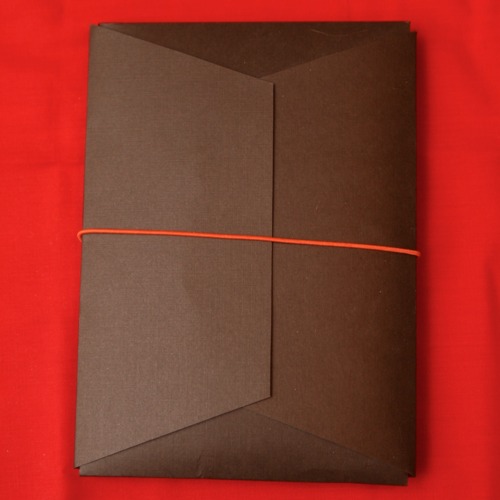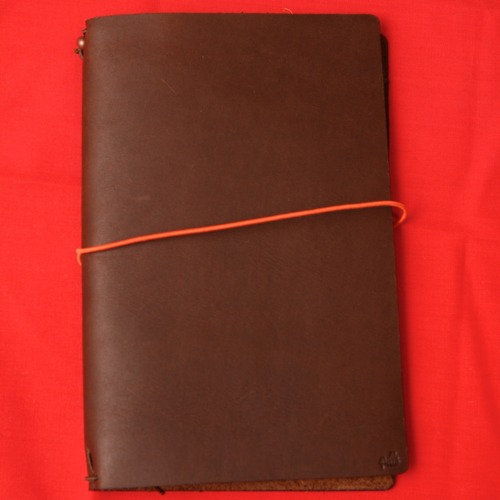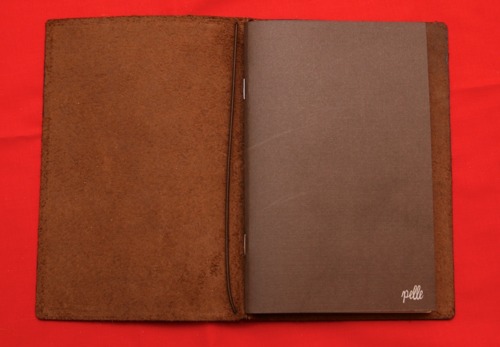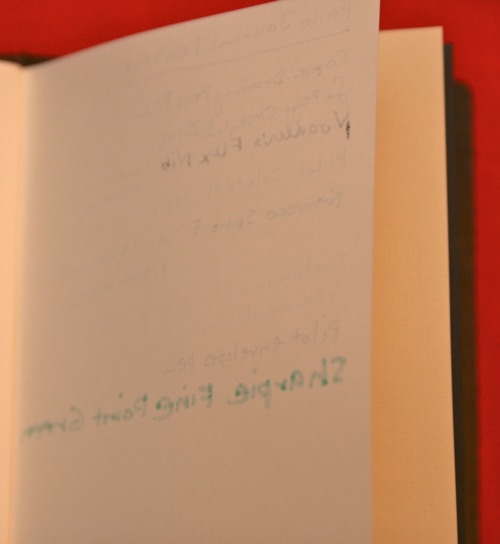The Pelle Journal is the American answer to the widely-coveted Japanese Midori Traveler’s notebook. I got the medium-sized notebook which does not align with either of the two sizes available for the Midori books. The small “passport-sized” books seem too small to be truly useful at about 3.5”x5”. I’m curious about the classic “traveler-sized” which is taller at approximately 8.5”x5” which is a touch wider than the Midori edition which is wildly revered by Patrick Ng of Scription. I think the medium-size is a fine place to start on my journey with leather, elastic-bound, multi-book notebooks.

First, I must say that the packaging is lavish with a similar level of fanfare to the Midori, with a folding paper wrapping held closed with the signature orange elastic band.

Inside, the book is within a cotton, drawstring bag and a note from Pelle is included as well as an extra elastic.

The cover is an unlined, supple brown leather with an elastic around the cover in bright orange. Its absolutely yummy to the touch.

I put the Pelle next to my daily-use notebook, an Ecosystem Life, which is comparable to a large Moleskine (approx 5.5”x8.5” in size). Overall, the Pelle medium is only about an inch smaller overall.

The bead holds the ribbon bookmark in place and its attached to the leather cover, not to the individual booklets. The ribbon bookmark seems a tad bit too short to be really useful but I’m hoping it can be altered or replaced.

The journal contains a cardstock covered booklet that is staple-bound with 64-pages of cream paper. The internal notebook is 4.25”x6.75”.

There are three elastic bands running down the spine of the leather cover so that multiple booklets can be carried at once. Additional booklets can be purchased for $8.99 each, available in lined or plain.
Of course, the most important point to cover with any notebook is how well the paper takes ink or pencil.

These are the pens and pencils used in the test: Kaweco Sport F fountain pen, Palomino Blackwing 602, Pilot Envelope Pen, Le Pen, Sanford Sharpie Fine Point, Copic Drawing Pen F02, Noodler’s Flex Nib fountain pen, Pilot Coleto Hi-Tec C gel pens and 0.5mm mechanical pencil.

The only pen I had trouble using on the paper was the Copic Drawing Pen. I don’t know if the ink was drying and sticking or if the paper was so smooth that it didn’t provide enough friction for the inexpensive fountain pen. In writing tests, the paper is silky smooth which is great for very fine point gel pens and the Le Pens. Pencils are also very smooth on the paper.

On the reverse side of the paper only the fountain pen ink has a tiny bit of show-through though the Flex nib showed the most bleed-through. And of course, Sharpies bleed though but that’s not unexpected. The paper performs extremely well overall.
In conclusion, the leather cover is understated and beautiful. The ability to customize the contents of your book with a variety of paper stocks, including drawing paper, is a great option. Being able to keep the same cover seems like a good environmental option as well. The paper is good quality, more opaque than Moleskine. At the moment, Pelle does not offer the range of accessories that Midori offers that is part of the appeal (stickers, pockets, extra charms, calendar inserts, etc.). Some of Midori’s extras may fit into some of Pelle journals if you want to try to get the “Midori look”. On the upside, the Pelle books are made in the US, available through Jet Pens (read: FREE SHIPPING!) and $20 less expensive than Midori.
